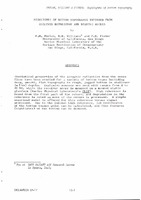| dc.contributor.author | Phelan, F. M. | |
| dc.contributor.author | Williams, Robert Bruce | |
| dc.contributor.author | Fisher, F. H. | |
| dc.date.accessioned | 2018-10-11T14:10:09Z | |
| dc.date.available | 2018-10-11T14:10:09Z | |
| dc.date.issued | 1975/10 | |
| dc.identifier | 309 | |
| dc.identifier.govdoc | CP-17/4 | |
| dc.identifier.uri | http://hdl.handle.net/20.500.12489/722 | |
| dc.description.abstract | Statistical properties of the acoustic reflection from the ocean floor have been studied for a var i.ety of bottom types including deep, smooth, flat topography thorough, jagged bottom in shallower (~l km) depths. Explosive sources a r e used with r anges from 4 to 20 lan, while the receiver array is mounted on a moored stable platform (Marine Physical Laboratory's FLIP). High coherence is found from the first part of the return, and degradation in the coherence is noted as more of the return is processed. A simple empirical model is offered for this coherence versus signal processed. Due to the initial high coherence, 3-D coordinates of the bottom bounce point can be calculated, and fine features (highlights) of the bottom can be deduced. | |
| dc.format | 7 p. : ill. ; digital, PDF file | |
| dc.language | English | |
| dc.publisher | NATO. SACLANTCEN | |
| dc.source | In: Ocean Acoustic Modelling (SACLANTCEN Conference Proceedings CP-17), Part 4, 1975, pp. 13-1 - 13-7. | |
| dc.subject | Seafloor | |
| dc.subject | Acoustic reflection | |
| dc.subject | Shallow water | |
| dc.title | Highlights of bottom topography inferred from received depression and bearing angles | |
| dc.type | Papers and Articles | |
| dc.type | Conference Proceedings (CP) | |
